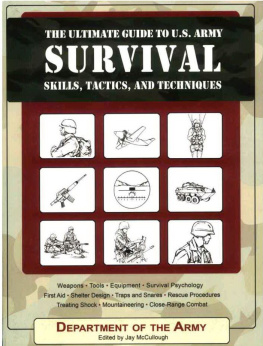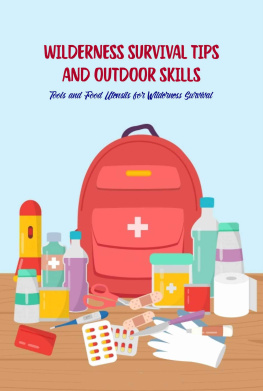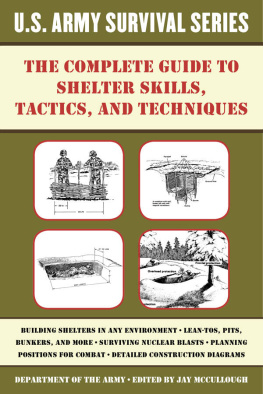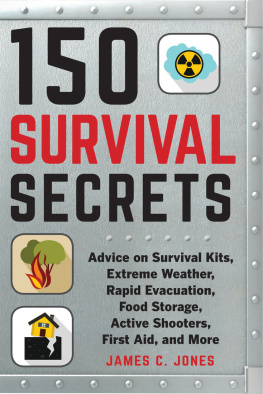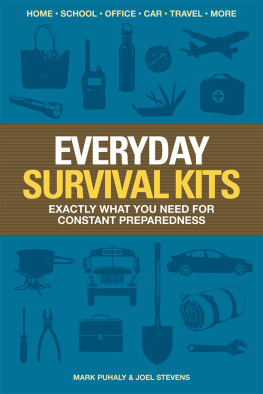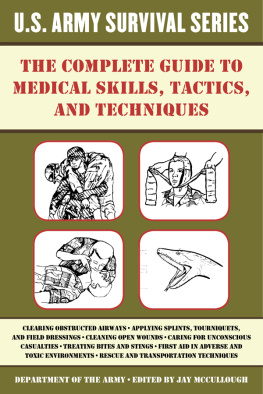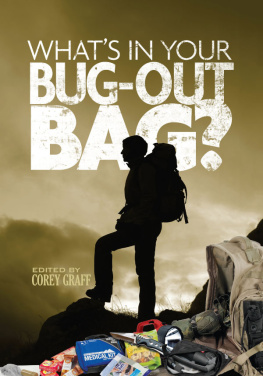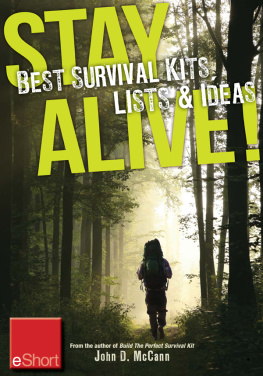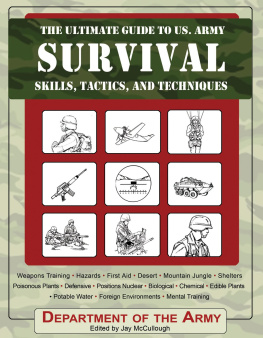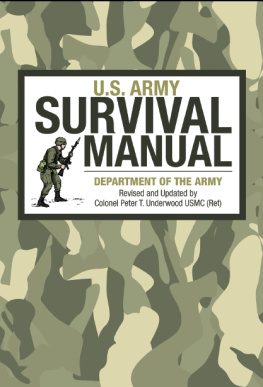Table of Contents
Copyright 2007 by Skyhorse Publishing
All Rights Reserved. No part of this book may be reproduced or transmitted in any form by any means, electronic or mechanical, including photocopying and recording, or by any information storage or retrieval system, except as may be expressly permitted in writing by the publisher. Requests for permission should be addressed to Skyhorse Publishing, 555 8th Avenue, Suite 903, New York, NY 10018
www.skyhorsepublishing.com
10987654321
Library of Congress Cataloging-in-Publication Data
The ultimate guide to U.S. Army survival skills, tactics, and techniques / edited by Jay
McCullough.
p. cm.
ISBN-13: 978-1-60239-050-8 (alk. paper) ISBN-10: 1-60239-050-9 (alk. paper)
1. Unified operations (Military science) 2. Operational art (Military science) I. McCullough, Jay.
U260.U48 2007
355.54dc22
2007016415
Printed in the United States of America
INTRODUCTION
The U.S. has the best-equipped and well-trained Army in the world. Barring unforeseen political considerations or a catastrophic act of nature, it can deploy nearly anywhere and accomplish almost any reasonable mission. This is due in large part to the Armys experience as an institution in a variety of wartime environments. Its hard-earned wisdom about how to cope with almost every imaginable scenario, on a soldier-by-soldier basis, distinguishes it as a service of excellence whose individuals are highly adaptable. They are well prepared, they accomplish the mission, and when the circumstances are truly unfavorable to life itself, they are survivors.
The keys to this preparation are contained in the Armys many sensible, well-written, voluminous, and scattered publications. They address nearly every aspect of running, provisioning, or being in the Army, but they are especially useful for their tips on how to stay alive under any circumstances. The task of culling every bit of useful information about survival from every U.S. Army publication would take months however, so Ive done it here for you in The Ultimate Guide to U.S. Army Survival Skills, Tactics, and Techniques.
Where subjects are duplicated throughout the literature, Ive created a single clearinghouse for that information. For instance, almost every Army manual remotely connected to survival seems to include the same basic instructions about how to make a poncho lean-to, so youll find a single discussion about that, and related information, in the Shelters section.
In other instances, a subject may be discussed in-depth in a more generalized or comprehensive manner, say for example venomous snakes as a subcategory of dangerous animals. But the subject of snakes also merits inclusion in other categories, especially within the contexts of those categories; jungle, desert, and medical manuals add valuable information not otherwise contained in a herpetologists catalog of snake habitats, habits, and geographical ranges.
Ive tried to make the selections useful to a general reader who may find him- or herself in a survival situation, whether they are alone or in a small group, probably unarmed. Some sections are invaluable; nearly every aspect of first aid will be useful to someone at some time. When in doubt about whether particular passages provide pertinent information, Ive included them in the hope that they may serve as a useful reference, comfort the afflicted, or perhaps even save a life. As an example, you will find a caution in the first aid section that warns you not to apply a tourniquet to someones neck.
Will you ever dig a defensive position with a sloping floor and a grenade trench? Probably not. But everyone who has done so probably never thought about it until they were up to their shoulders in dirt, wondering how much further they had to dig. I should hope that you never find yourself in that circumstance, or one like it. If you do, the best advice is contained in the first three chapters, particularly in regard to your state of mind. Whatever your condition, keep a positive outlook, keep your sense of humor, keep your humanity and sense of decency. Realize the conditions for what they are, be flexible, adapt, and never say die.
Jay McCullough
January 2007
New Haven, Connecticut
PART I
General Survival Skills
CHAPTER 1
Psychology of Survival
INTRODUCTION
This manual is based entirely on the keyword SURVIVAL. The letters in this word can help guide you in your actions in any survival situation. Whenever faced with a survival situation, remember the word SURVIVAL.
SURVIVAL ACTIONS
The following paragraphs expand on the meaning of each letter of the word survival. Study and remember what each letter signifies because you may some day have to make it work for you.
S - Size Up the Situation. If you are in a combat situation, find a place where you can conceal yourself from the enemy. Remember, security takes priority. Use your senses of hearing, smell, and sight to get a feel for the battlefield. What is the enemy doing? Advancing? Holding in place? Retreating? You will have to consider what is developing on the battlefield when you make your survival plan.
Size Up Your Surroundings. Determine the pattern of the area. Get a feel for what is going on around you. Every environment, whether forest, jungle, or desert, has a rhythm or pattern. This rhythm or pattern includes animal and bird noises and movements and insect sounds. It may also include enemy traffic and civilian movements.
Size Up Your Physical Condition. The pressure of the battle you were in or the trauma of being in a survival situation may have caused you to overlook wounds you received. Check your wounds and give yourself first aid. Take care to prevent further bodily harm. For instance, in any climate, drink plenty of water to prevent dehydration. If you are in a cold or wet climate, put on additional clothing to prevent hypothermia.
Size Up Your Equipment. Perhaps in the heat of battle, you lost or damaged some of your equipment. Check to see what equipment you have and what condition it is in.
Now that you have sized up your situation, surroundings, physical condition, and equipment, you are ready to make your survival plan. In doing so, keep in mind your basic physical needswater, food, and shelter.
U - Use All Your Senses, Undue Haste Makes Waste. You may make a wrong move when you react quickly without thinking or planning. That move may result in your capture or death. Dont move just for the sake of taking action. Consider all aspects of your situation (size up your situation) before you make a decision and a move. If you act in haste, you may forget or lose some of your equipment. In your haste you may also become disoriented so that you dont know which way to go. Plan your moves. Be ready to move out quickly without endangering yourself if the enemy is near you. Use all your senses to evaluate the situation. Note sounds and smells. Be sensitive to temperature changes. Be observant.
R - Remember Where You Are. Spot your location on your map and relate it to the surrounding terrain. This is a basic principle that you must always follow. If there are other persons with you, make sure they also know their location. Always know who in your group, vehicle, or aircraft has a map and compass. If that person is killed, you will have to get the map and compass from him. Pay close attention to where you are and to where you are going. Do not rely on others in the group to keep track of the route. Constantly orient yourself. Always try to determine, as a minimum, how your location relates to

